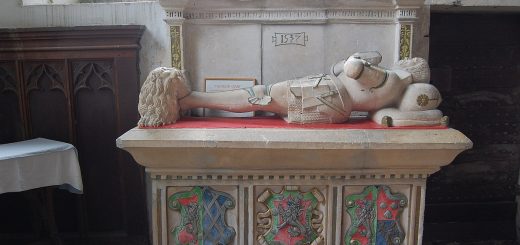St George’s Day
Today St George’s Day is not celebrated in England with anywhere near the vigour it was in past centuries, and is actually celebrated more in other countries that share his patronage, with traditions that have not been broken for hundreds of years. There is however currently a campaign to return it to the same status it had before the 18th century, when it was allegedly a popular festival.
 In some ways St George seems a strange patron for England: little is known of his actual life (discounting mythology), he was not born and never even set foot in England, although one tradition places his birth at Coventry. There is some controversy as to whether he should stay the patron Saint at all, a recent poll suggesting that St Alban, Britain’s first Christian Martyr from the late 3rd Century, would be a popular replacement.
In some ways St George seems a strange patron for England: little is known of his actual life (discounting mythology), he was not born and never even set foot in England, although one tradition places his birth at Coventry. There is some controversy as to whether he should stay the patron Saint at all, a recent poll suggesting that St Alban, Britain’s first Christian Martyr from the late 3rd Century, would be a popular replacement.
So who is St George? as with many mythical figures the strands of myth and reality have become so intertwined it is difficult to get a clear historical picture of the man. Most sources suggest that he was born in Cappadocia, in what is now Turkey sometime in the 3rd Century (AD303 being the most common date). He was brought up as a Christian, and moved to Lydda in Palestine where he joined the Roman army, eventually attaining the rank of Tribune, which was in military terms a Legion Commander with rank of Centurion, although there are other interpretations of the title depending on time-frame, a basic interpretation would be an officer with some political clout[1].
When the Christian faith came under one of its many Roman purges under the Emperor Diocletian, George resigned his post and is reputed to have torn up the persecution order from the Emperor. For this act of treason George was imprisoned, tortured and eventually dragged through the streets Diospolis (in Palestine) where he was beheaded after refusing to deny his faith.
 The legend involving the dragon and his heroic exploits was a later addition popularised during the crusades, but it seems unclear when it was added to his story. The earliest account of St George in Britain was recorded by St Adamnan of Iona in the 7th century, he was also mentioned by the venerable Bede. According to some sources his legend spread in the 8th Century due to a similarity with his story and an Anglo Saxon legend, that allowed a smooth transition into common knowledge.
The legend involving the dragon and his heroic exploits was a later addition popularised during the crusades, but it seems unclear when it was added to his story. The earliest account of St George in Britain was recorded by St Adamnan of Iona in the 7th century, he was also mentioned by the venerable Bede. According to some sources his legend spread in the 8th Century due to a similarity with his story and an Anglo Saxon legend, that allowed a smooth transition into common knowledge.
His popularity increased during the crusades and his status as a Patron Saint was developed by the English Kings. Edward the III has been placed as the King who started the path to his patronage when he created the Order of the Garter in 1350, although St George’s day had already been recognised as the 23rd April by the synod of Oxford in 1222. He was popularised even more by Henry V in the 15th C and was even supposed to have appeared at the battle of Agincourt. The popularity of the Saint achieved a wider audience when his legend was printed in a book entitled The Golden Legend in 1483, which was a translation of a French bishops stories about the lives of the Saints.
This particular version includes the dragon legend which was by then entrenched with the myth. The story of George slaying the Dragon and saving the maiden encompasses many folklore motifs, and creates a medieval chivalric ideal of the hero. In condensed form George defeats a dragon who has been terrorising the countryside and saves the King’s daughter who has been offered as a sacrifice. The subdued Dragon is led through the streets by the King’s daughter, and is only killed by St George after the King and his people convert to Christianity.
It would be interesting to know when the dragon legend became associated with the Saint. Was it just simply a medieval addition to make him more of an archetypal knight as a patron of the soldier , or was there perhaps an existing story associated with another hero that the story of St George became adapted to. In some ways it may denote a much older tradition (mythic cycle) that predates Christianity. Some historians have indeed come to the conclusion that the story is a Christianised version of Pagan deities. Fraser in his ‘The Golden Bough’ suggests that St George’s Day replaced the pagan festival of Parilia, and many of the customs still practiced abroad are related to welcoming the spring and ceremonies to fertilise the fields for the coming harvest.
St George’s day remained a popular festival until the 18th Century when the festival lost favour, as it was reduced to a simple day of devotion in 1778. In 1969 the Catholic Church downgraded St George to the lowest ranking possible as an optional feast day.
In some cultures St George’s day is celebrated on the 5th of May in accordance with the Gregorian calendar. (other festivals that still use the dates before the change to our present Julian calendar are the old New year festivals such as Burghead Clavie festival).
Bram Stoker mentions the festival as falling on the 5th of May in his book Dracula, as a day when evil holds sway – from midnight on the eve for 24 hours[2]. Whether Bram Stoker drew on existing traditions or exercised artistic license for this particular association is unclear, but he does place the day in the older time frame.
In Britain the earliest church dedicated to St George is at Fordington in Dorset, where the story that he is supposed to have appeared during a battle during the Crusades is recorded[3]. The legend also finds its place in other areas of Britain in Hertfordshire North of Brinsop Church is a field known as Lower Stanks where – according to local lore – St George had his battle with the dragon, a twelfth century carving in the church also commemorates this tradition, which if the age is correct[4] shows a very early interpretation of the legend before its popularity and mass circulation with the book: The Golden Legend. It is interesting to see that the dragon is depicted as a worm – an older motif type. One interpretation for the white horse of Uffington is that it is an image of the dragon St George slew, with Dragon Hill nearby. St George is also the hero in some of the ancient English Mumming plays.
St George is also patron Saint of: Georgia, Catalonia, Valencia, Serbia, Bosnia, Bulgaria, Macedonia, and also the cities: Moscow, Genoa and Beirut. He is patron Saint of Horses, shepherds, soldiers, chivalry, farmers, field workers, farmers and the modern Scouting movement.
For modern campaigns see:
Royal Society of St George
St George’s Day Events Company
St George’s Day.com
[1] Please correct me if I am wrong here various sources mentioned George reaching rank of Tribune but the actual interpretation of Tribune within the Roman Army seems to vary considerably, with Tribunus being a senior officer but meaning different things as other terms are added to it. Didn’t want to delve too deep into Roman history for this short article.
[3] [4] Folklore, Myths and Legends of Britain – Readers Digest




Recent Comments